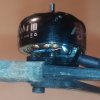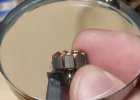hi all,
after a crash (but on the other side) a motor doesn't spin anymore, I checked and there isn't continuity between power in wires and the esc outputs, but also there wasn't continuity between one wire of the motore and the others two so I saw that it broke off on the side of the motor, I soldered it as you can see in the image and now there is continuity between all three but the motor still doesn't work as you can see in the video. it doesn't have black burn marks, doesn't seem crooked and manually spins like the others, is it dead?
thank you
after a crash (but on the other side) a motor doesn't spin anymore, I checked and there isn't continuity between power in wires and the esc outputs, but also there wasn't continuity between one wire of the motore and the others two so I saw that it broke off on the side of the motor, I soldered it as you can see in the image and now there is continuity between all three but the motor still doesn't work as you can see in the video. it doesn't have black burn marks, doesn't seem crooked and manually spins like the others, is it dead?
thank you


